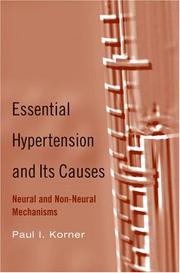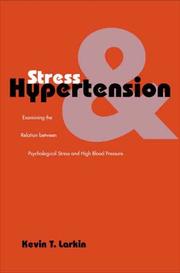| Listing 1 - 7 of 7 |
Sort by
|
Book
ISBN: 9535126156 9535173111 9535126148 Year: 2016 Publisher: IntechOpen
Abstract | Keywords | Export | Availability | Bookmark
 Loading...
Loading...Choose an application
- Reference Manager
- EndNote
- RefWorks (Direct export to RefWorks)
Essential hypertension is a quantitative characteristic that is important for correlating with the rate of morbidity and mortality in the developed and developing countries. The etiology of essential hypertension is complex. This work, authored by renowned researchers in the field, gives updated concepts about essential hypertension. Novel advanced topics are presented in a sole document as hypertension in children; the contribution in the psychiatric comorbidities associated with it; mechanisms of omega-3 in protection against hypertension-related organ damage; oxidative stress at different levels; genetics-associated studies; the role of pollution in essential hypertension; personalized healthcare in a hypertensive patient; and hypertension-related disparities between ethnic groups. It can conclude so that essential hypertension is one of the hottest topics in contemporary medicine.
Essential hypertension. --- Hyperpiesia --- Idiopathic hypertension --- Primary hypertension --- Hypertension --- Physiology
Book
ISBN: 9535152343 9535102826 Year: 2012 Publisher: IntechOpen
Abstract | Keywords | Export | Availability | Bookmark
 Loading...
Loading...Choose an application
- Reference Manager
- EndNote
- RefWorks (Direct export to RefWorks)
This book, authored by renowned researchers in the field of Hypertension Research, details the state of the art knowledge in genetics, genomics and pathophysiology of Essential hypertension, specifically the genetic determinants of hypertension and role of gene variants in response to anti-hypertensive therapy. Two chapters describe mitochondrial mutations in Essential hypertension and in hypertension associated Left ventricular hypertrophy, one chapter reviews in detail the global gene expression in hypertension, and an up to date treatise on pathophysiology of resistant hypertension is detailed in another chapter. Other topics included in the book are end organ damage, baroreceptor sensitivity and role of music therapy in essential hypertension.
Essential hypertension. --- Hyperpiesia --- Idiopathic hypertension --- Primary hypertension --- Hypertension --- Medical genetics

ISBN: 1281158720 9786611158729 019535740X 1429486147 9780195357400 9780195094831 0195094832 6611158723 019770655X 0190282541 Year: 2006 Publisher: New York : Oxford University Press,
Abstract | Keywords | Export | Availability | Bookmark
 Loading...
Loading...Choose an application
- Reference Manager
- EndNote
- RefWorks (Direct export to RefWorks)
Essential hypertension. --- Hypertension. --- Blood pressure, High --- High blood pressure --- Vascular hypertension --- Blood circulation disorders --- Hyperpiesia --- Idiopathic hypertension --- Primary hypertension --- Hypertension --- etiology.

ISBN: 1281729191 9786611729196 030012886X 9780300128864 9781281729194 0300106440 9780300106442 Year: 2005 Publisher: New Haven : Yale University Press,
Abstract | Keywords | Export | Availability | Bookmark
 Loading...
Loading...Choose an application
- Reference Manager
- EndNote
- RefWorks (Direct export to RefWorks)
Does living a stress-filled life lead to elevated blood pressure? And if so, do strategies to better manage stress effectively lower blood pressure? In this authoritative and comprehensive book, Kevin T. Larkin examines more than a half-century of empirical evidence obtained to test the common assumption that stress is associated with the onset and maintenance of essential hypertension (high blood pressure).While the research confirms that stress does play a role in the exacerbation of essential hypertension, numerous other factors must also be considered, among them obesity, exercise, and smoking, as well as demographic, constitutional, and psychological concerns. The author discusses the effectiveness of strategies developed to manage stress and thereby lower blood pressure and concludes with suggestions and directions for further study.
Essential hypertension --- Stress (Psychology) --- Emotional stress --- Mental stress --- Psychological stress --- Tension (Psychology) --- Mental health --- Psychology --- Diathesis-stress model (Psychology) --- Life change events --- Type A behavior --- Hyperpiesia --- Idiopathic hypertension --- Primary hypertension --- Hypertension --- Etiology.
Book
Year: 2021 Publisher: Basel, Switzerland MDPI - Multidisciplinary Digital Publishing Institute
Abstract | Keywords | Export | Availability | Bookmark
 Loading...
Loading...Choose an application
- Reference Manager
- EndNote
- RefWorks (Direct export to RefWorks)
Climate change poses a serious challenge to our health and wellbeing. The increasing frequency of extreme weather events such as floods, droughts, and heatwaves, and the direct impacts of changes in temperature have direct impacts on health. At the same time, broader environmental change affects infectious disease risk, air pollution, and other forms of exposure. The different ways in which climate change will affect health are complex, interactive, and different communities are disproportionately affected. International actions such as the Paris Agreement and the Sustainable Development Goals recognise the future risks to society and acknowledge that we are already committed to a certain level of climate change. Future adaptation measures therefore need careful assessment and implementation for us to be able to minimise the potential risks from climate change and, at the same time, maximise the potential health benefits of a cleaner, greener world. This Special Issue comprises original research articles and detailed reviews on the likely impacts of climate change on health in a range of geographical settings, and the potential for adaptation measures to reduce some of these risks. Ultimately, studies like these will motivate policy level action for mitigation and help in determining the most effective methods of adaptation to reduce negative impacts in future through embedding scientific evidence into practice.
heat-waves --- heat-related mortality --- 2003 --- 2015 --- climate change --- Germany --- air temperature --- hot days --- heat waves --- city --- urban area types --- Poznań --- Poland --- ambulance 999 calls --- extreme weather --- resource planning --- London --- UK --- heat --- mortality --- adaptation --- dwellings --- indoor temperature --- cold days --- cold waves --- health systems --- climate adaptation --- health infrastructure --- rescue services --- Northern Europe --- disaster risk reduction --- Sendai Framework --- demographic change --- infectious diseases --- vector-borne diseases --- aerosolized exposures --- pollen --- well-being --- public health --- land management --- patient and public involvement (PPI) --- land-use --- El Niño Southern Oscillation --- ENSO --- health --- climatic variability --- climate-sensitive disease --- workplace --- heat stress --- productivity loss --- beta distribution --- North Atlantic Oscillation --- weather --- emergency ambulance calls --- exacerbation of essential hypertension --- urban heat island --- urban planning --- heat resilience --- climate scenarios --- waterborne disease --- natural environment --- risks --- cryptosporidiosis --- cholera --- leptospirosis --- Legionnaires’ disease --- trends over time --- n/a --- Poznań --- El Niño Southern Oscillation --- Legionnaires' disease
Book
Year: 2020 Publisher: Basel, Switzerland MDPI - Multidisciplinary Digital Publishing Institute
Abstract | Keywords | Export | Availability | Bookmark
 Loading...
Loading...Choose an application
- Reference Manager
- EndNote
- RefWorks (Direct export to RefWorks)
Arterial hypertension affects about 1 billion people worldwide and it is the strongest modifiable risk factor for cardiovascular disease and related disability. Since the initial discovery of rare monogenic disorders with large effects, the role of genomics has evolved into large genome-wide association studies detecting common variants with a modest effect size. Similarly, pharmacogenomics has emerged as a new tool for understanding variability in drug response, to maximize efficacy and reduce toxicity. This book presents the most recent advances in the field of genetics and genomics of arterial hypertension and their potential impact on clinical management. The book is a useful tool for clinicians but also to the research community and those who want to be updated in the field.
atrial natriuretic peptide --- T2238C variant --- endothelial dysfunction --- smooth muscle cells contraction --- platelet aggregation --- epigenetics --- cardiovascular diseases --- renin --- low-renin --- hypertension --- mineralocorticoid receptor --- genetics --- aldosterone --- essential hypertension --- blood pressure --- genome-wide association studies --- exome microarray --- next-generation sequencing --- rare variants --- rare-variants association testing --- burden test --- sequence kernel association test --- hypokalemia --- low renin hypertension --- monogenic hypertension --- Liddle syndrome --- SCNN1A --- SCNN1B --- SCNN1G --- non-coding RNA --- micro RNA --- primary aldosteronism --- aldosterone-producing adenoma --- transcriptome profiing --- DNA methylation --- histone modifications --- vascular smooth muscle cells --- endothelial cells --- Kruppel-like factor 15 --- left ventricular hypertrophy --- cardiac hypertrophy --- heart failure --- genetics of left ventricular hypertrophy --- fibromuscular dysplasia --- non atherosclerotic vascular stenosis --- PHACTR1 --- genetic association --- cervical artery dissection --- spontaneous coronary arteries dissection --- CRY1 --- CRY2 --- HSD3B1 --- HSD3B2 --- cardio-tonic steroids --- endogenous ouabain --- adducin --- renal damage --- African American --- ARMC5 --- GRK4 --- CACNA1D --- endocrine hypertension
Book
Year: 2022 Publisher: Basel MDPI - Multidisciplinary Digital Publishing Institute
Abstract | Keywords | Export | Availability | Bookmark
 Loading...
Loading...Choose an application
- Reference Manager
- EndNote
- RefWorks (Direct export to RefWorks)
Dear colleagues, This Special Issue, “Endothelial Dysfunction: From Pathophysiology to Novel Therapeutic Approaches”, focuses on the pathophysiology of endothelial dysfunction, new biomarkers for endothelial dysfunction related to cardiovascular disorders or tumors, and novel therapeutic approaches for endothelial dysfunctions. Vascular endothelium is an active tissue and plays a crucial role in the maintenance of vascular homeostasis. Chronic exposure to risk factors, such as hypertension, high cholesterolemia, or oxidative stress, induces endothelial dysfunctions and results in a loss of endothelial integrity, smooth muscle cell proliferation, and macrophage recruitment. The pathophysiology of endothelial dysfunction (ED) is complex and multi-factorial factors are involved, such as oxidative stress or chronic inflammation. The primary prevention of cardiovascular risk factors and endothelial dysfunctions, as well as the early detection of or molecular imaging techniques for endothelial dysfunction, helps to prevent the development of cardiovascular disorders. Novel therapeutic approaches or drug delivery systems for endothelial dysfunctions have had promising beneficial effects in preclinical or clinical levels by affecting the progression of atherosclerotic changes, tumor angiogenesis, and host–immune reactions near tumor environments.
endothelial cells --- oxidative stress --- inflammageing --- endothelial dysfunction --- aldehyde dehydrogenase-2 --- cardiovascular disease --- neurovascular disease --- vascular inflammation --- APE1/Ref-1 --- cardiovascular diseases --- subcellular localization --- serological biomarkers --- atherosclerosis --- aerobic exercise --- PCSK9 --- LOX-1 --- insulin resistance --- macrophage polarity --- serum γ-glutamyltransferase --- essential hypertension --- cardiovascular risk factors --- angiogenesis --- nargenicin A1 --- compound 9 --- VEGF --- VEGFR2 --- HIF-1α --- electronegative low-density lipoprotein --- LDL(–) --- L5 LDL --- oxidized LDL --- oxLDL --- ADMA --- arginine --- arginine paradox --- BH4 --- blood pressure --- COVID-19 --- dietary supplements --- endothelium --- eNOS uncoupling --- heart failure --- hypertension --- L-arginine --- myocardial infarction --- NADPH --- nitric oxide --- peripheral artery disease --- ApoE knockout mouse --- atorvastatin --- VCAM-1 --- galectin-3 --- neutrophil/lymphocyte ratio --- electronegative LDL --- LDL(−) --- lectin-like oxLDL receptor-1 --- dyslipidemia --- chronic venous insufficiency --- prolyl oligopeptidase (POP) --- inflammation --- endothelial disfunction --- lung disease --- endothelial to mesenchymal transition --- pulmonary hypertension --- pulmonary fibrosis --- metformin --- diabetes --- CV risk --- hyperglycemia --- glycated lipoproteins --- glycated LDL --- glycated HDL --- endothelial cell dysfunction --- molecular mechanisms --- epigenetic factors --- therapeutic approaches --- vasoactive factors --- EndoMT --- TGF-β --- epigenetics --- endothelial cell --- glycolysis --- metabolism --- pathological angiogenesis --- tumor microenvironment --- MRI (magnetic resonance imaging) --- high-fat diets --- plaque burden --- low-level laser therapy --- phototherapy --- vascular disease --- healing --- ischemia --- vascular calcification --- chronic kidney disease --- CKD --- uremic toxins --- hyperphosphatemia --- vascular smooth muscle cells --- VSMCs --- macrophages --- n/a --- LDL(-)
| Listing 1 - 7 of 7 |
Sort by
|

 Search
Search Feedback
Feedback About UniCat
About UniCat  Help
Help News
News